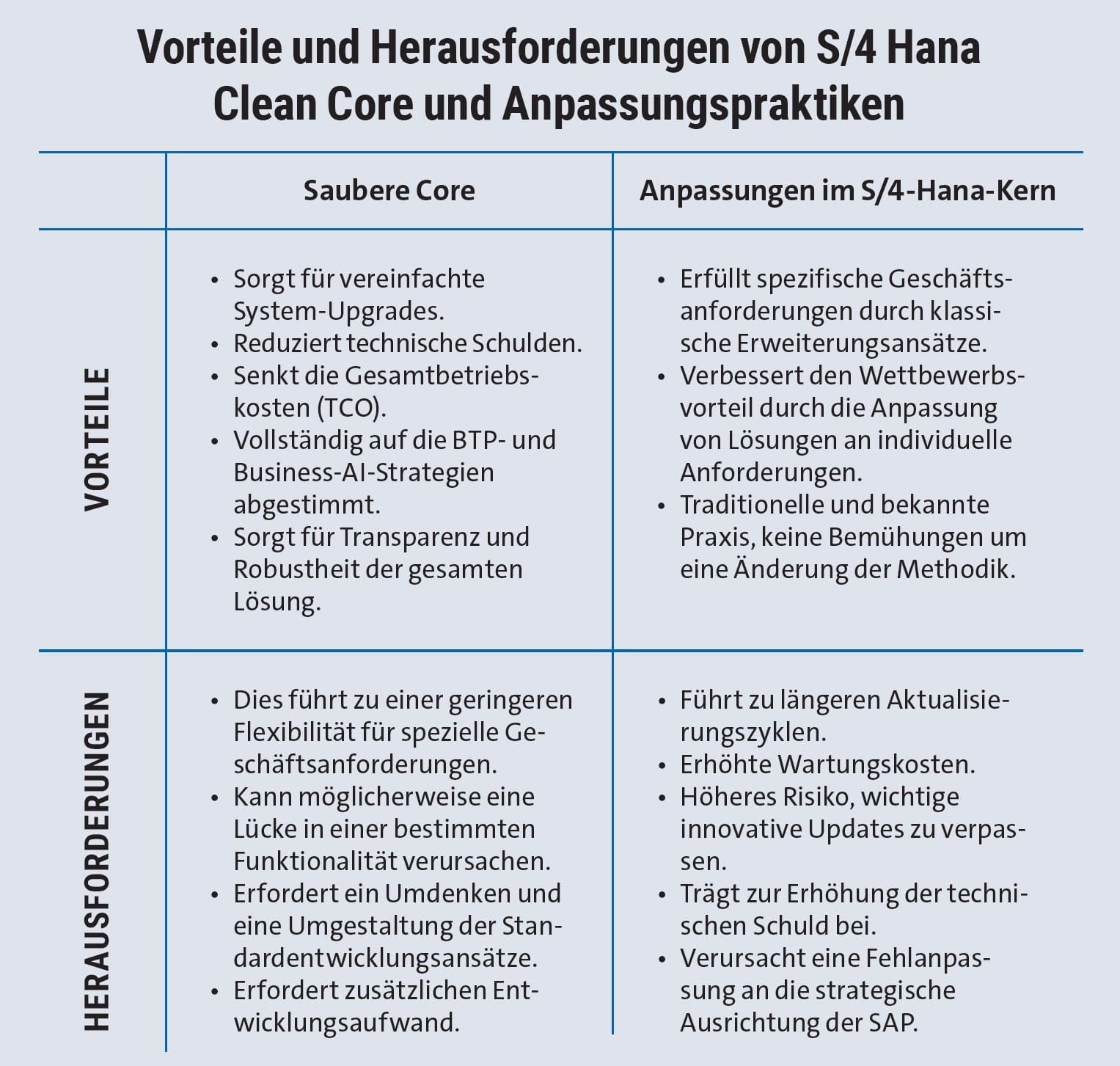ERP world formula


Finding the balance between standard ERP functionality and the pursuit of new, innovative business functions not covered by the system is key in S/4 Hana transformations. A clean core practice promotes simplicity of system expansion and helps manage system upgrades with less effort and risk, aligning with SAP's long-term roadmap.
On the other hand, existing SAP customers often need to extensively customize internal processes in S/4 to meet unique market requirements and remain competitive. How can existing SAP customers find the right balance based on their individual priorities?
Clean core vs. customization
Once the decision for S/4 Hana has been made, existing SAP customers must determine the extent to which they want to rely on the standard functions of S/4. A clean core is closely aligned with the standard functions of an ERP, reduces technical debt, simplifies updates and ensures alignment with SAP's cloud and innovation strategies. A clean core also means that it remains up-to-date, transparent, unchanged, efficient and cloud-compatible. This includes ensuring that no changes are made, redundant extensions are eliminated, only approved APIs are used to ensure stability, and application extensibility is fully utilized.
Larger enhancement applications and integrations should be handled via the Business Technology Platform (SAP BTP). On the other hand, deep customization that touches the core of the system (direct access to system tables, functions and classes) offers the flexibility to adapt S/4 to specific operational requirements, but leads to complexity and takes us far away from the desired standardization.
Challenge: Clean Core
To determine whether existing SAP customers strictly adhere to the clean core practice or continue with the classic enhancement approach, it should first be checked whether the business processes can be adapted to fit into the standard functions of S/4 Hana. If customization is still necessary, it should be checked whether proven enhancement methods such as key user, developer and side-by-side enhancement with BTP can meet the requirements.
If these methods are not sufficient for critical business functions, classic custom extensions may need to be implemented within S/4 Hana, and SAP customers should be aware of the risks and create a plan to reduce this technical debt in the future if possible.
Ultimately, it's about finding a balance between the benefits of a clean core and covering all business functions and scenarios of customization, with a clear understanding of your current and future business needs.

The right balance
Step 1:Define your business strategy and evaluate clean core processes versus custom processes. Is your business focused on operational efficiency or differentiation? If your main goal is operational efficiency and cost reduction, you should prioritize a clean core with minimal customization and use standard ERP processes such as accounting, procurement and inventory management.
Differentiation: If your organization needs customization for specific business processes to gain a competitive advantage, consider customizing S/4 Hana Core for unique services or operations.
Step 2:: Work with experts! We recommend that you consult with experts experienced in BTP and S/4 Hana implementations at an early stage: as soon as you consider adopting a clean-core approach for your S/4 Hana implementation. LeverX specialists can provide you with tailored advice and solutions based on best practices to help you make informed decisions. We offer comprehensive solution packages for S/4 Hana implementation and Clean Core Practice with interactive workshop-style learning sessions. Using a human-centered approach, our team assesses business scenarios, identifies process gaps and facilitates collaborative sessions where business stakeholders and technical experts work together to find effective solutions.
Step 3:Analyze the long-term and short-term effects. Is long-term flexibility more important to you than immediate functional requirements? If you want to stay agile and be ready for future SAP updates, prioritize maintaining a clean core and externalizing customizations. If your current business requirements are too unique for standard solutions, make limited and targeted customizations while creating and following the plan for long-term adherence to clean core principles.
Step 4:Choose the right platform for customization. Which platforms can be chosen for customization? Check which platforms can be used to develop custom applications and workflows. For example, platforms such as BTP allow you to extend system functionality without directly impacting your core system. This approach can offer long-term benefits such as easier upgrades and lower technical debt. Alternatively, customization can be done directly on the S/4 Hana side using two proven approaches: Key User Extensibility or Developer Extensibility (Embedded Abap environment).
Step 5:Carry out a cost-benefit analysis. How high are the costs of customization compared to the benefits? Weigh up the costs of maintaining custom solutions (e.g. higher TCO, technical debt) against the strategic value they bring to your business.
Step 6Develop a clean core strategy. Create a strategy and milestones with your development team or vendor, taking into account the governance process for S/4 Hana enhancements. This includes plans for managing and reducing technical debt, setting up the required system components and solutions and licensing approach, developing roadmaps with key milestones and identifying risks along with a mitigation plan.
Step 7Iterate and evolve! As your business grows, so should your approach: regularly evaluate your SAP landscape to ensure your customizations remain relevant. Explore new technologies that can simplify or replace existing custom solutions. Use performance analysis and user feedback to evaluate the effectiveness of your customizations and their impact on system performance. Adapt your strategy as needed to new insights, new technologies or changing business objectives.
By following these steps, companies can make informed decisions that balance the need for innovation with the long-term benefits of a clean and easy-to-update system. Getting the balance between these two strategies wrong can have costly consequences.
One possible scenario, for example, would be that a company extensively adapts its system in order to optimize operations. While this may bring short-term benefits, over time it adds complexity, slows down upgrades and increases maintenance. In contrast, a clean core practice may keep the system flexible, but may not be able to meet specific requirements beyond SAP's classic custom enhancements.
Complementary strategies
So what is the solution? Instead of viewing clean core and customization as opposites, they should be seen as complementary strategies. This is where BTP comes in, allowing organizations to extend the capabilities of their system without compromising the core and providing a modular approach to innovation. With this solution, companies can adapt their applications to changing requirements while maintaining a clean, easily upgradable system for the future.
BTP for customizations
To illustrate how SAP BTP can strike a balance between the clean core debate and customization, let's look at a real-world example based on a LeverX customer success story. A global apparel company faced the challenge of managing different regional requirements while optimizing the S/4 core.
Instead of overhauling its core system with extensive customization, the company opted for BTP. This allowed the company to create custom applications and workflows specifically tailored to regional requirements, such as local tax compliance and supply chain management, without changing the core system.
By using BTP with LeverX, the company was able to achieve these goals: they quickly adapted to the requirements of the local market. Their S/4 core remained clean and agile. They have maintained a system that is easy to update and adapted to the latest innovations from SAP.
Not without change management
Adhering to S/4 Hana system standards and implementing new technologies like BTP can be transformative, but it's important to consider the human element of the digital landscape. Resistance to change is a common challenge, often stemming from fear of the unknown or disruption to established workflows. This resistance can significantly impact the success of your project and lead to delays or underutilization of the new systems.
Furthermore, digital transformation not only affects technology, but also changes the corporate culture. Changes to systems and processes can alter workflows, roles and team dynamics. Managing these cultural shifts through change management practices is critical to ensuring a smooth transition and maintaining employee engagement and productivity.
To better understand and manage these human aspects, we invite you to attend the Strategic IT Leadership Day at SAP AppHaus Heidelberg on November 28, 2024.
If you are interested in the topic but cannot attend the event, that's no problem: LeverX specialists are bookable via LeverX on Tour. We can arrange meetings and run change management workshops in different countries to address your specific needs and discuss how you can improve your SAP implementation. Get in touch to arrange a meeting and find out how we can help you with your digital transformation.
Conclusion:
There is no one-size-fits-all solution for balancing clean core and customization practices in SAP S/4 Hana. The right approach depends entirely on the specific needs of your organization, your long-term goals and the industry context. A careful assessment of your current SAP landscape will help you make decisions that meet both immediate needs and future aspirations. To master this balancing act, you should seek advice from the experts at LeverX.
You can meet us at the DSAG Annual Congress 2024 from October 15 to 17 in Leipzig to discuss your individual requirements in person. You will find our experts at stand Q2, hall 3. Alternatively, you can contact us at any time via our website to find out how we can support you in your transition to a future-proof system.





